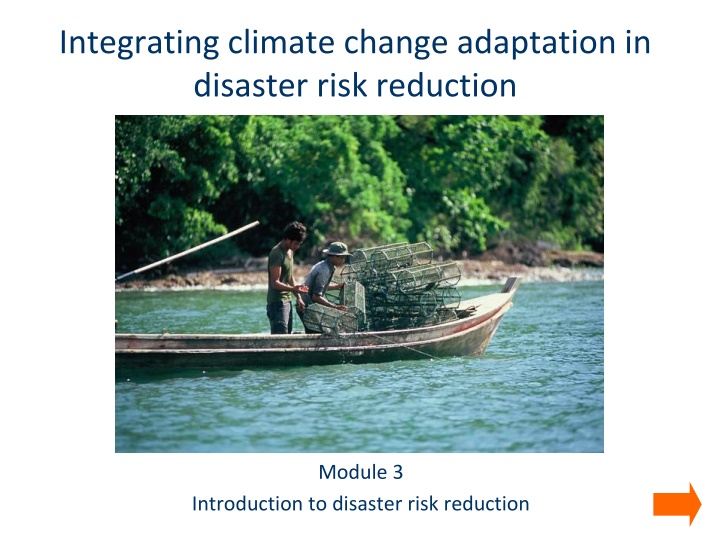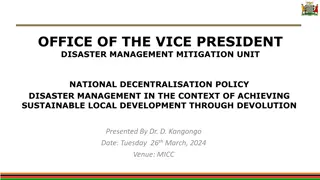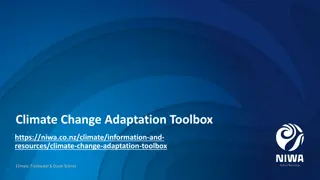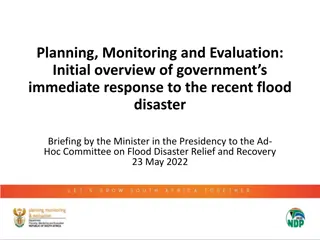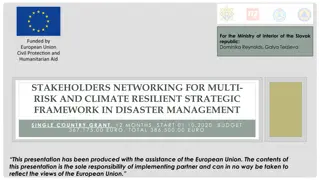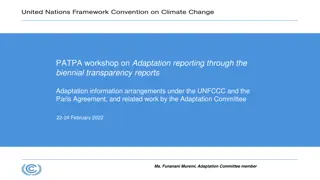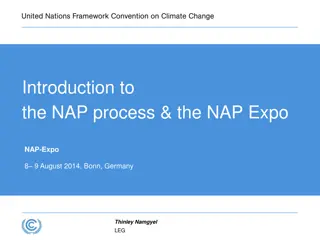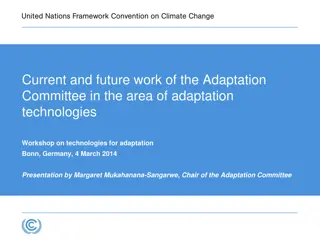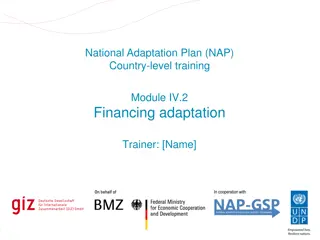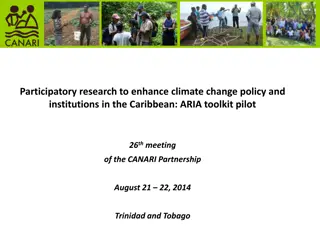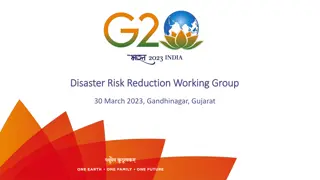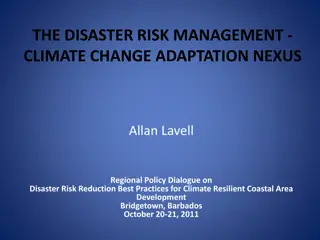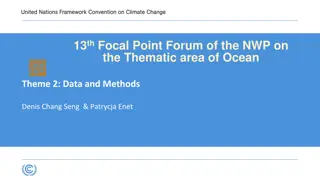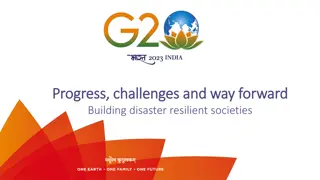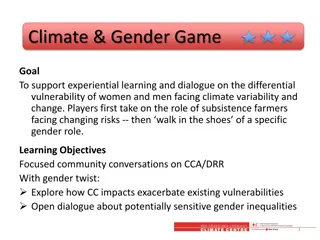Integrating Climate Change Adaptation in Disaster Risk Reduction
Welcome to e-Learning on integrating climate change adaptation in disaster risk reduction! This module is part of a package that includes five modules covering key concepts in disaster risk reduction and climate change adaptation. Developed for disaster risk reduction practitioners, these modules offer valuable insights and practical guidance for integrating adaptation strategies. Explore at your own pace and track your progress through the module. Engage with participatory action planning and project examples to enhance your understanding.
Download Presentation

Please find below an Image/Link to download the presentation.
The content on the website is provided AS IS for your information and personal use only. It may not be sold, licensed, or shared on other websites without obtaining consent from the author.If you encounter any issues during the download, it is possible that the publisher has removed the file from their server.
You are allowed to download the files provided on this website for personal or commercial use, subject to the condition that they are used lawfully. All files are the property of their respective owners.
The content on the website is provided AS IS for your information and personal use only. It may not be sold, licensed, or shared on other websites without obtaining consent from the author.
E N D
Presentation Transcript
Integrating climate change adaptation in disaster risk reduction Module 3 Introduction to disaster risk reduction
Welcome to e-Learning on integrating climate change adaptation in disaster risk reduction! This module is part of an e-Learning package on integrating climate change adaptation in disaster risk reduction. The package includes five modules: 1. Concepts in disaster risk reduction and climate change adaptation 2. Understanding vulnerability 3. Introduction to disaster risk reduction 4. Introduction to climate change adaptation 5. Guiding principles for integrating adaptation in disaster risk reduction We recommend that you work through the modules in the specified order. To access the other e-Learning modules, please visit the: e-Learning Center - Integrating climate change adaptation in disaster risk reduction NOTE: You will need a user name and password to access the e-Learning Center. If you do not have an account, please contact: MinervaSupport@care.ca
Who are the e-Learning modules for? How were they developed? The e-Learning modules are designed for disaster risk reduction (DRR) practitioners. This includes practitioners within CARE, as well as our civil society and government partner organizations. They were developed by Raks Thai Foundation and CARE, with significant inputs from CARE experts on climate change adaptation and disaster risk reduction, and most importantly from practitioners engaged in DRR initiatives in Country Offices across the Asia Pacific Region, as well as in Raks Thai Foundation. Practitioner perspectives were gathered through two workshops. An initial workshop was conducted to develop the overall framework and brainstorm on key content. In the second workshop, the draft modules were tested and feedback was gathered. The current version reflects inputs from both workshops. The modules reflect CARE s current thinking on integrating adaptation in DRR initiatives. They should be considered as working versions. Our approach will be tested and refined as we develop more experience in this area. Please send any feedback on these modules to Bruce Ravesloot: ravesloot@careclimatechange.org
You can move through the module at your own pace. Introduction DRR project cycle We estimate that this module will take you approximately 1 hour to complete. Assessment/ analysis However, everyone learns at a different speed, so you should feel comfortable moving at your own pace. Participatory action planning The map on the right helps you to track your progress through the module. Where you are will be highlighted in orange. Implementation Evaluation We recommend that you go through the module in sequence, however you will have the option of jumping forwards or backwards by clicking on the map. Project example Knowledge Review At any point, you can go back to the previous slide by clicking the back arrow. Use the forward arrow to move through the module.
Throughout the module, youll find links to key definitions. This e-Learning module is designed to be as clear and user-friendly as possible. So, as we introduce different concepts, we ll use simple language and examples to promote understanding. However, we will also provide links to official definitions for those who prefer this approach. Any time you see underlined text in the module, you can click to access the official definition. Are you ready? Then let s get started!
Module 3 Introduction to disaster risk reduction
Modules 1 and 2 focused on building understanding of important concepts for disaster risk reduction. Introduction Introduction DRR project cycle DRR project cycle To review from Modules 1 and 2: Assessment/ analysis Assessment/ analysis Climate change makes disaster risk reduction even more important. Participatory action planning Participatory action planning With the exception of geophysical hazards, climate change affects all types of natural hazards. Implementation Implementation Vulnerability to climate change and disasters: Evaluation Depends on exposure to hazards. Evaluation Is determined by human, social, physical, natural, political and financial factors. Project example Project example Varies within communities and even within households. Knowledge Review Knowledge Review More capacity means less vulnerability.
Lets start by reminding ourselves what we mean by disaster risk reduction. Introduction Introduction DRR project cycle DRR project cycle Disaster risk reduction (DRR) is an approach to reduce disaster risks caused by hazard events. It refers to the practical actions that society, communities or other stakeholders take to reduce the risk of disasters. Assessment/ analysis Assessment/ analysis Participatory action planning Participatory action planning DRR aims to reduce exposure to hazard events, to reduce vulnerability, and to improve preparedness. Implementation Implementation Ideally, DRR actions take place within the framework of a disaster risk management (DRM) policy, strategy or plan. Evaluation Evaluation Project example Project example Knowledge Review Knowledge Review Because climate change increases the frequency, severity and intensity of climate-related hazards, it provides a strong imperative for DRR actions.
Why is DRR important in the communities we work in? Introduction Introduction DRR project cycle DRR project cycle As discussed in Module 1, hazard events can have a wide range of negative effects, including: Assessment/ analysis Assessment/ analysis Injury, illness or loss of life Participatory action planning Participatory action planning Destruction of property or assets Implementation Interruption in services Implementation Harm to or loss of livelihoods Evaluation Evaluation Damage to ecosystems Project example Psycho-social impacts Project example A hazard event can set back or completely reverse development progress that has been made. Knowledge Review Knowledge Review In almost every disaster situation, it is the poorest and most vulnerable people who suffer most.
DRR includes disaster prevention, mitigation and preparedness. Introduction Introduction DRR project cycle DRR project cycle Prevention: Actions that avoid the adverse impacts of hazards Assessment/ analysis Assessment/ analysis Example: avoidance of areas at risk of hazard event Participatory action planning Participatory action planning Mitigation: Actions that reduce the direct impact of a hazard Implementation Implementation Example: improving drainage systems for rainwater Evaluation Evaluation Preparedness: Actions that enhance capacity to respond to a disaster event that has occurred Project example Project example Example: establishment of community disaster response teams, prepositioning emergency response materials Knowledge Review Knowledge Review
Lets look at a typical project cycle for a disaster risk reduction initiative. Introduction Introduction DRR project cycle DRR project cycle Evaluation Assessment/ analysis Assessment/ analysis Assessment/ analysis Assessment/ analysis Evaluation Participatory action planning Participatory action planning Implementation Implementation Evaluation Evaluation Implementation Execution of activities and monitoring Participatory action planning Implementation Execution of activities and monitoring Project example Participatory action planning Project example Knowledge Review Knowledge Review Click on the orange boxes for a brief description of each stage.
Engaging stakeholders throughout the process is an important success factor for DRR. Introduction Introduction DRR project cycle DRR project cycle Key stakeholders that need to be involved in DRR initiatives include: Assessment/ analysis Assessment/ analysis Community members, including representatives of vulnerable groups Participatory action planning Participatory action planning Authorities at all levels Implementation Implementation Civil society organizations Technical specialists Evaluation Evaluation Private sector Project example Research institutes Project example Media Knowledge Review Knowledge Review These stakeholders must be involved in all stages of the project cycle.
There are a few things to keep in mind in the assessment/analysis phase. Introduction Introduction DRR project cycle DRR project cycle During disaster risk assessment/analysis, it is important to: Assessment/ analysis Assessment/ analysis Use complementary assessment approaches to look at different aspects of disaster risks Participatory action planning Participatory action planning Incorporate participatory approaches Implementation Use methods that allow triangulation of data Implementation Adapt methods to social/cultural customs Evaluation Evaluation Use methods that are sensitive to gender and power dynamics Project example Project example Ensure that the most vulnerable groups are represented in the process Knowledge Review Knowledge Review Be flexible in your approach
Based on the results of the assessment/analysis stage, we can decide which DRR approach to take. Introduction Introduction DRR project cycle DRR project cycle There are three main approaches to disaster risk reduction: Assessment/ analysis Assessment/ analysis If disaster risks are high, the objective of the action is specifically to reduce disaster risk/increase resilience. Participatory action planning Participatory action planning If disaster risks are medium, objectives are linked to other domains, but activities/results are made more resilient. Implementation Implementation Evaluation If disaster risks are low, no reference is made to disaster risk/resilience (though disaster risks should be systematically monitored). Evaluation Project example Project example Knowledge Review Knowledge Review
Based on the results of the assessment/analysis stage, we can decide which DRR approach to take. Introduction Introduction DRR project cycle DRR project cycle These different approaches to DRR are shown in the graphic below. Assessment/ analysis Assessment/ analysis Participatory action planning Participatory action planning Implementation Implementation Evaluation Evaluation Project example Project example Knowledge Review Knowledge Review For the remainder of the e-Learning process, we will be assuming that we are pursuing the first option, where explicit DRR activities are being implemented.
In planning an explicit DRR initiative, there are several things to take into consideration when deciding on activities. Introduction Introduction DRR project cycle DRR project cycle Considerations for planning explicit DRR activities include: Assessment/ analysis Priorities identified in DRM policies, strategies or plans of relevant authorities Assessment/ analysis Participatory action planning Participatory action planning Different hazards the communities are dealing with and their relative impacts on lives and livelihoods Implementation Implementation Feasibility, cost-effectiveness and sustainability of different DRR actions Evaluation Evaluation Availability of necessary technical expertise to implement the action Project example Project example Potential for negative unintended effects Knowledge Review Knowledge Review Ensuring actions benefit the most vulnerable and address the underlying causes of vulnerability
Based on the assessment, and taking the above factors into consideration, you may identify a number of different types of DRR activities. Introduction Introduction DRR project cycle DRR project cycle For example, to reduce the risk of disaster caused by flooding, activities could include: Assessment/ analysis Assessment/ analysis Early warning systems Participatory action planning Participatory action planning Raising embankments Implementation Improving drainage Implementation Raising wells Evaluation Evaluation Swimming lessons Project example Providing boats Project example Providing safe shelters Knowledge Review Knowledge Review
Along with actions that explicitly address disaster risks, you may also identify activities that achieve other objectives in addition to reducing disaster risks. Introduction Introduction DRR project cycle DRR project cycle Some examples of these types of activities could include: Assessment/ analysis Assessment/ analysis Sustainable ecosystem management Participatory action planning Diversifying and/or strengthening livelihoods Participatory action planning Strengthening community organization Implementation Implementation Strengthening institutional capacity Evaluation Building schools that double as shelters for floods or cyclones Evaluation Project example Project example Knowledge Review Knowledge Review REFLECTION Consider your own DRR projects. Do they incorporate these types of dual purpose activities?
Once you have identified and prioritized activities, you can move into implementation. This stage involves execution of activities and monitoring. Introduction Introduction DRR project cycle DRR project cycle There are a couple of key things to keep in mind during the implementation of DRR projects: Assessment/ analysis Assessment/ analysis Develop activities that meet the project objectives. Participatory action planning Participatory action planning Adopt a flexible approach so that you can adjust according to changes in context. Implementation Implementation Evaluation This will help to ensure that your DRR initiative is both effective and sustainable. Evaluation Project example Project example Monitoring is a key tool for achieving this. Knowledge Review Knowledge Review
Monitoring in DRR initiatives involves two key aspects. Introduction Introduction DRR project cycle DRR project cycle Monitoring of hazards, for example: Assessment/ analysis Assessment/ analysis Monitoring environmental changes Participatory action planning This monitoring can be linked to early warning systems Participatory action planning Implementation Monitoring of vulnerability, for example: Implementation Households in unsafe locations Evaluation Evaluation Adherence to building codes Project example Functioning of local risk management groups Project example Poverty levels Knowledge Review Knowledge Review
Evaluation in DRR initiatives looks at two important dimensions. Introduction Introduction DRR project cycle DRR project cycle Evaluation in DRR initiatives evaluates both the process and the results Assessment/ analysis Assessment/ analysis Results are evaluated in terms of: - Effectiveness - Efficiency - Coverage - Relevance to local needs and priorities - Appropriateness to context - Alignment with policies - Any unintended impacts Participatory action planning Participatory action planning Implementation Implementation Evaluation Evaluation Project example Project example Knowledge Review Knowledge Review
Lets look at an example of a DRR project. Introduction Introduction DRR project cycle DRR project cycle In Krabi province in southern Thailand, Raks Thai Foundation is working with six coastal communities to facilitate planning for disaster risk management and the implementation of targeted DRR activities on a pilot basis. Assessment/ analysis Assessment/ analysis Participatory action planning Participatory action planning The planning will use a community-based disaster risk management (CBDRM) approach, working with local leaders, resource persons and community members. Implementation Implementation The project will act as a learning lab for community- based disaster risk management, with explicit integration of adaptation to climate change. It will provide learning, guidance and experiences that will be useful to DRM practitioners throughout the region. Evaluation Evaluation Project example Project example Knowledge Review Knowledge Review
The CBDRM approach adopted by the project involves ten key steps. Introduction Introduction DRR project cycle DRR project cycle The ten steps in the CBDRM process are: Assessment/ analysis Assessment/ analysis 1. An initiating the process from policy coordination to selection 2. Information development Participatory action planning Participatory action planning 3. Community awareness raising 4. Coordination of local implementing partners Implementation Implementation 5. Establishment of volunteers and working group on CBDRM Evaluation 6. Development of CBDRM plan Evaluation 7. Administration and implementation of CBDRM plan Project example Project example 8. Monitoring and evaluation 9. Strengthening learning processes Knowledge Review Knowledge Review 10. Linking to sustainable community development
The core of the process is the development of the CBDRM plans. Introduction Introduction DRR project cycle DRR project cycle The project has formed working groups of trained local leaders, and resource persons. These working groups are collaborating with participating coastal communities to establish CBDRM committees and facilitate the development of CBDRM plans. These plans will be linked to CBDRM plans and early warning systems at both sub-district and provincial levels. Assessment/ analysis Assessment/ analysis Participatory action planning Participatory action planning Implementation Implementation The CBDRM plans are currently under development. They address disaster response, preparedness, disaster risk reduction and rehabilitation. Evaluation Evaluation Project example Project example Knowledge Review Knowledge Review
The communities have identified a range of activities within their CBDRM plans. Introduction Introduction DRR project cycle DRR project cycle Activities in the CBDRM plans developed to date include: Mangrove and beach forest resource management Fishery resource restoration Study and pilot activities on solutions for controlling coastal erosion, such as bamboo walls and beach forest tree plantation Establishing evacuation routes and safe evacuation areas Establishing boat parking areas in canals for use during monsoon season Establishment of early warning systems Capacity building for local stakeholders on DRR and adaptation Establishing community DRR funds Assessment/ analysis Assessment/ analysis Participatory action planning Participatory action planning Implementation Implementation Evaluation Evaluation Project example Project example Knowledge Review Knowledge Review
Lets review the key learning points for this module. Introduction Introduction DRR project cycle DRR project cycle DRR aims to reduce exposure to hazard events, to reduce vulnerability, and to improve preparedness. Assessment/ analysis Assessment/ analysis The project cycle for DRR consists of four key stages: assessment/analysis; participatory action planning; implementation (execution of activities and monitoring); and evaluation. Participatory action planning Participatory action planning Implementation Implementation Engaging stakeholders is very important throughout the project cycle. Evaluation Evaluation Project example Explicit DRR actions specifically aim to reduce disaster risk/increase resilience. Project example Knowledge Review Knowledge Review
Ready to review your knowledge? Introduction Introduction DRR project cycle DRR project cycle In this module, we ve introduced the basics of disaster risk reduction. Assessment/ analysis Assessment/ analysis Next, you ll have a chance to review your knowledge before moving on to the next module. Participatory action planning Participatory action planning Implementation Ready? Implementation If you feel you re ready for the knowledge review, click on the forward arrow. Evaluation Evaluation Not quite there yet? Project example Project example If you d like to go through any of the concepts again before moving on to the knowledge review, click on the appropriate box in the map. Knowledge Review Knowledge Review
Knowledge Review Question 1 Introduction Introduction DRR project cycle DRR project cycle Which of the following is an example of a disaster mitigation activity which could form part of a DRR initiative? Assessment/ analysis Assessment/ analysis Participatory action planning Participatory action planning Establishing community disaster response teams Improving drainage systems for rainwater Avoidance of areas at risk Establishing community disaster response teams Implementation Improving drainage systems for rainwater Implementation Avoidance of areas at risk Evaluation Evaluation Project example Project example Knowledge Review Knowledge Review Click on the appropriate box to indicate your answer.
Knowledge Review Question 2 Introduction Introduction DRR project cycle DRR project cycle At what stage of the project cycle for a targeted DRR project do we begin to engage stakeholders? Assessment/ analysis Assessment/ analysis Participatory action planning Participatory action planning Assessment/analysis Participatory action planning Execution of project activities Implementation Implementation Participatory action planning Execution of project activities Assessment/ analysis Evaluation Evaluation Project example Project example Knowledge Review Knowledge Review Click on the appropriate box to indicate your answer.
Congratulations! Youve completed Module 3. We hope that you have found this to be a useful learning experience. To access the other e-Learning modules, please visit the: e-Learning Center - Integrating climate change adaptation in disaster risk reduction NOTE: You will need a user name and password to access the e- Learning Center. If you do not have an account, please contact: MinervaSupport@care.ca Thank you for your participation! You can exit the module by pressing the Esc key.
